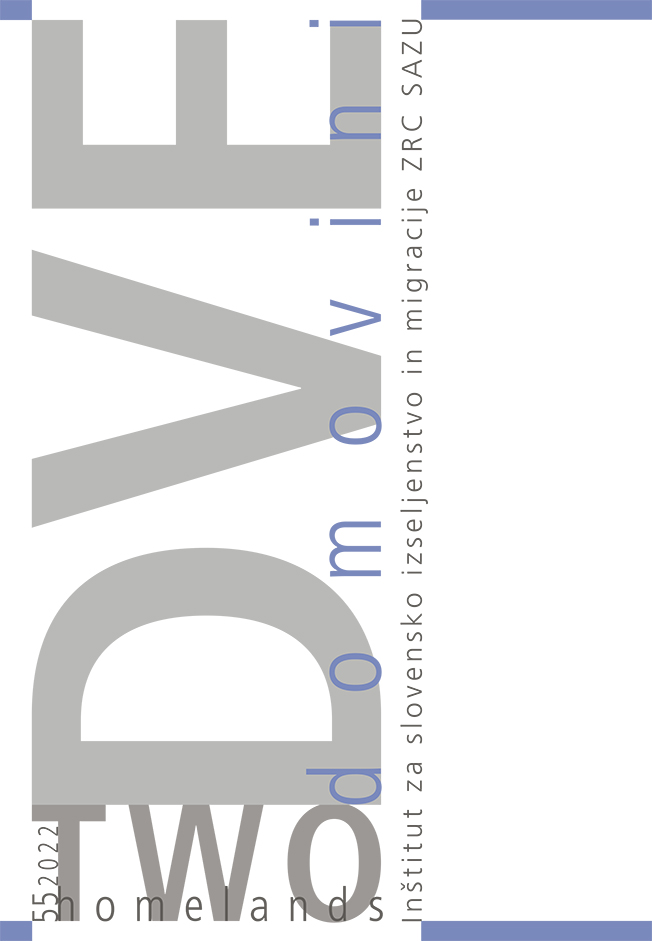Kraljevina Ogrska in diasporična intervencija v ZDA v zgodnjem 20. stoletju
DOI:
https://doi.org/10.3986/dd.2022.1.02Ključne besede:
Avstro-Ogrska, migracije, Ameriška akcija, panslavizemPovzetek
Avstro-ogrski voditelji so v odgovoru na čezatlantske migracije delovali zelo intervencijsko, prizadevali so si vzdrževati lojalnost svoje diaspore v Ameriki. Ta prispevek razkriva aktivno vlogo, ki jo je imela avstro-ogrska vlada – še posebej pa Urad ogrskega predsednika vlade – pri nadzoru lojalnosti migrantov v ZDA od leta 1902 do izbruha prve svetovne vojne. Raziskuje tako uspehe politike kot proteste, ki jih je ta povzročala. Intervencija je sledila čezmorskim selitvam – vlada je upravljala s selitveno birokracijo in si je prek tiska, cerkve in kulturnih dogodkov prizadevala za vključitev v življenje izseljencev. Več ukrepov Avstro-Ogrske za vzdrževanje lojalnosti je imelo ravno nasprotne učinke od želenih in je podžgalo proteste migrantov.
Prenosi
Literatura
Agstner, Rudolf (2012). Austria(-Hungary) and its Consulates in the United States of America Since 1820. Berlin: LIT Verlag.
Apponyi, Albert (1935). The Memoirs of Count Apponyi. New York: Macmillan Company.
Benkart, Paula K. (1983). The Hungarian Government, the American Magyar Churches, and Immigrant Ties to the Homeland, 1903–1917. Church History 52, 312–321.
Braun, Marcus (1906). Immigration Abuses; Glimpses of Hungary and Hungarians: A Narrative of the Experiences of an American Immigrant Inspector while on Duty in Hungary, Together with a Brief Review of That Country’s History and Present Troubles. New York: Pearson Advertising Co.
Budapesti Hírlap (1884). 21. 11. [1884?].
Choate, Mark I. (2008). Emigrant Nation: The Making of Italy Abroad. Cambridge: Harvard University Press.
Frank, Tibor (1999). Ethnicity, Propaganda, Myth-Making: Studies on Hungarian Connections to Britain and America, 1848–1945. Budapest: Akadémiai Kiadó.
Hale, Chandler (1902). Letter to John Hay, 4. 11. 1902. National Archives and Records Administration, T-157, Reel 48. Washington, DC.
Hungary Active Here: Finds Disloyal Subjects in the United States: Tries to Retain Hold on Slavonians and Ruthenians (1903). Boston Evening Transcript, 27. 7. 1903.
Hungary Exposed: Secret state document reveal[s] the plotting of that government in the United States: American Slovaks and Ruthenians, “the Irish of Hungary,” to be the victims (1903). (Copy can be found at the New York Public Library, New York, NY, mistakenly with a suspected publication date of 1907.)
Kazinczy, Béla (1902). Report of 11 Apr. 1902. Magyar Nemzeti Levéltár – Országos Levéltára [Hungarian National Archives] (MNL OL), K26, 575 cs., 20 tét.
Kende, Géza (1927). Magyarok Amerikában: Az Amerikai Magyarság Története, 1583–1927 Cleveland: Szabadság.
Kuthy, Alexander (1918). Letter to Consul of Sweden, 3. 8. 1918. Haus-, Hof-, und Staatsarchiv (HHStA), PA XXXIII, 101.
Letter to Ottokar Czernin (1915). Document 6977a, [1915?]. Haus-, Hof-, und Staatsarchiv (HHStA), PA XXXIII, 99.
Maxwell, Alexander (2009). Slavic Hungary, the Czechoslovak Language and Accidental Nationalism. London: IB Tauris.
Memorial Presented by the Roman Catholic Priests of Slovak Nationality to their Eminences the Cardinal Archbishop, Archbishops and Bishops of the United States (1902). Wilkes-Barre, PA. (Copy can be found in the Warshaw Collection of Business Americana Subject Categories: Religion, Subseries 4: Publications, circa 1791–1933, Box 3, Folder 4, Archives Center, National Museum of American History, Smithsonian Institution, Washington, DC)
Mérey, Kajetan (1902). Letter to US Embassy in Vienna, 31. 10. 1902. National Archives and Records Administration (NARA), T-157, Reel 48.
More About that Hungarian Flag (1902). Springfield Republican, 1. 9. 1902, 4.
Nageleisen, Urbam C. (1904). Letter to Consul Thomas von Dessewffy, 22. 12. 1904. Haus-, Hof, und Staatsarchiv (HHStA), AR F15, 30.
Phelps, Nicole M. (2013). U.S.-Habsburg Relations from 1815 to the Paris Peace Conference: Sovereignty Transformed. Cambridge: Cambridge University Press.
Poznan, Kristina Evans (2018). “Migrant Nation-Builders: The Development of Austria-Hungary’s National Projects in the United States, 1880s–1920s.” PhD diss., College of William & Mary.
Priest Exposes Plot: Hungarian Scheme to Retain Control of Emigrants (1903). Washington Post, 26. 7. 1903, 6.
Puskás, Julianna (1982). Kivándorló Magyarok az Egyesült Államokban, 1880–1940. Budapest: Akadémiai Kiadó.
Slovak National Committee (1911). Count Albert Apponyi: The So-called Angel of Peace and what He Stands for in Hungary. Cleveland, OH, USA.
Steidl, Annemarie (2020). On Many Routes: Internal, European, and Transatlantic Migration in the Late Habsburg Empire. West Lafayette: Purdue University Press.
That Hungarian Flag (1902). Springfield Republican, 7. 9. 1902, 8.
The Cesko-Americka Tiskova Kancelar (1912). Denní Hlasatel, 29. 4. 1912.
The Third Year of Activity of the Cesko-Americka Tiskova Kancelar. Denní Hlasatel, 17. 11. 1912.
von Nuber, Alexander (1902). Letter to Ladislas von Hengelmüller, 16. 7. 1902. Magyar Nemzeti Levéltár – Országos Levéltára [Hungarian National Archives] (MNL OL), K26, 575 cs., 20 tét.
von Nuber, Alexander (1903). Report to Carl von Giskra, 8. 8. 1903. Magyar Nemzeti Levéltár – Országos Levéltára [Hungarian National Archives] (MNL OL), K26, 605 cs., 20 tét.
von Nuber, Alexander (1910). Letter to K.u.K. Foreign Ministry, 10. 10. 1910. Haus-, Hof-, und Staatsarchiv (HHStA), AR F15, 31.
von Ploennies, Hermann Ritter (1911). Report of 19 Apr. 1911. Haus-, Hof-, und Staatsarchiv (HHStA), AR F15, 29.
Zahra, Tara (2016). The Great Departure: Mass Migration from Eastern Europe and the Making of the Free World. New York: W.W. Norton & Co.
Prenosi
Objavljeno
Verzije
- 2022-08-27 (4)
- 2022-06-13 (3)
- 2022-06-13 (2)
- 2022-01-31 (1)
Kako citirati
Številka
Rubrike
Licenca

To delo je licencirano pod Creative Commons Priznanje avtorstva-Nekomercialno-Brez predelav 4.0 mednarodno licenco.
Avtorji jamčijo, da je delo njihova avtorska stvaritev, da v njem niso kršene avtorske pravice tretjih oseb ali kake druge pravice. V primeru zahtevkov tretjih oseb se avtorji zavezujejo, da bodo varovali interese založnika ter da bodo povrnili morebitno škodo.
Podrobneje v rubriki: Prispevki





